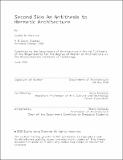| dc.contributor.advisor | Azra Aksamija. | en_US |
| dc.contributor.author | Chesrow, Sophia W. (Sophia Wong) | en_US |
| dc.contributor.other | Massachusetts Institute of Technology. Department of Architecture. | en_US |
| dc.date.accessioned | 2018-10-22T18:26:58Z | |
| dc.date.available | 2018-10-22T18:26:58Z | |
| dc.date.copyright | 2018 | en_US |
| dc.date.issued | 2018 | en_US |
| dc.identifier.uri | http://hdl.handle.net/1721.1/118656 | |
| dc.description | Thesis: M. Arch., Massachusetts Institute of Technology, Department of Architecture, 2018. | en_US |
| dc.description | This electronic version was submitted by the student author. The certified thesis is available in the Institute Archives and Special Collections. | en_US |
| dc.description | Cataloged from student-submitted PDF version of thesis. | en_US |
| dc.description | Includes bibliographical references (pages 142-143). | en_US |
| dc.description.abstract | This exploration is framed around 3 near-future scenarios where the world has been transformed by environmental disasters. Basically our immunological bubble has been broken. For years, we have tried to control our environment by creating a separate homeostatic interior. And In the process of trying to achieve physical comfort, not only have we standardized our sensorial conditions into a homogenous experience, we have also destroyed the larger environment. While most of us knew that this bubble was going to burst at some point, none of us were prepared... Now in the post bubble world, we have slowly come to the realization that the answer is not to create bigger or better bubbles. Instead, we need to develop a second skin. Operating at the body scale, this series of prosthetics teaches us how to reintegrate our senses with the environment. They restore our natural ability to interact with air, water, and heat in a world post hermetic seals. Rather than simply protecting us in another mini bubble, they function as a layer of mediation between us and our environment. | en_US |
| dc.description.statementofresponsibility | by Sophia W. Chesrow. | en_US |
| dc.format.extent | 151 pages | en_US |
| dc.language.iso | eng | en_US |
| dc.publisher | Massachusetts Institute of Technology | en_US |
| dc.rights | MIT theses are protected by copyright. They may be viewed, downloaded, or printed from this source but further reproduction or distribution in any format is prohibited without written permission. | en_US |
| dc.rights.uri | http://dspace.mit.edu/handle/1721.1/7582 | en_US |
| dc.subject | Architecture. | en_US |
| dc.title | Second Skin : an antithesis to hermetic architecture | en_US |
| dc.title.alternative | Antithesis to hermetic architecture | en_US |
| dc.type | Thesis | en_US |
| dc.description.degree | M. Arch. | en_US |
| dc.contributor.department | Massachusetts Institute of Technology. Department of Architecture | |
| dc.identifier.oclc | 1056952594 | en_US |
